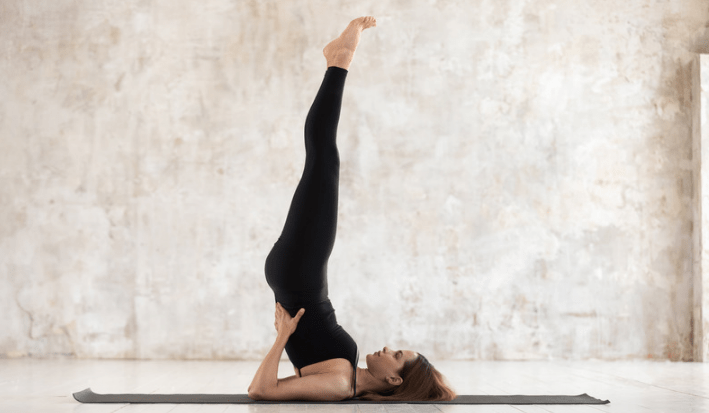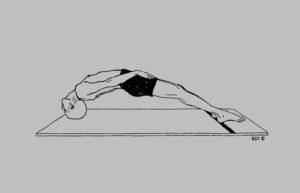The Shoulder Stand, or Sarvangasana, is a potent yoga pose with numerous physical and psychological advantages. Because of its energizing benefits on the entire body, it is regarded as one of the most significant and advantageous poses in yoga. We will discuss how to perform Sarvangasana, its advantages, and the safety measures to take when attempting this pose in this blog.
How to Practice Sarvangasana (Shoulder Stand):
- Preparation: Laying on your back with your arms by your sides and your palms facing down is the first step in preparation. To help your body and mind relax, take a few deep breaths.
- Lift the Legs: With your legs slowly raised off the ground and into a vertical position, contract your core muscles. As you raise your legs, use your hands and elbows to support your lower back.
- Support the Back: After raising your legs, elevate your complete lower body off the ground by using your hands to support your lower back. This will raise your torso so that it is perpendicular to the floor.
- Straighten the Legs: Raise your legs straight and in line with your body as you do so. Your upper arms and shoulders, not your neck, should be supporting your weight.
- keep the stance: Try to keep the stance for one to three minutes, or for as long as it seems comfortable, while maintaining a relaxed neck and taking deep breaths. Lower your legs carefully and consciously back to the floor to exit the pose.
Benefits of Sarvangasana (Shoulder Stand):
- Better Circulation: Sarvangasana encourages blood flow to the head, neck, and upper body, which helps reduce stress and enhance circulation in general.
- Thyroid Stimulation: It is well known that this position stimulates the thyroid gland, which can help control metabolism and enhance endocrine system performance.
- Relief from tension and Anxiety: Sarvangasana’s inverted posture can promote relaxation and lessen tension and anxiety by soothing the nervous system.
- Strengthens Shoulders and Back: Sarvangasana improves posture and spinal stability by strengthening the shoulders, upper back, and core muscles.
- Digestive Benefits: By squeezing and activating the abdominal organs, this pose can help with digestion and ease digestive problems.
Precautions for Sarvangasana (Shoulder Stand):
- Avoid during Menstruation and Pregnancy: Women should abstain from performing Sarvangasana throughout their menstrual cycles, as well as during pregnancy.
- Neck Injury or Issues: Under the supervision of a certified yoga instructor, those with neck injuries or problems involving the cervical spine should avoid this position or modify it.
- High Blood Pressure and Eye Disorders: Before attempting Sarvangasana, people with high blood pressure, glaucoma, or other eye disorders should speak with a healthcare provider.
- Precautions for Inversion: People who have high blood pressure, vertigo, or cardiac problems should exercise cautiously or not at all.
- Support and Alignment: It’s important to practice Sarvangasana with appropriate back and shoulder support and to make sure the pose doesn’t put undue strain on the neck.
Join yoga in rishikesh
To sum up, the Shoulder Stand, also known as Sarvangasana, is an advanced yoga pose that has several physical and mental advantages. But it’s important to proceed cautiously with this stance, particularly for those who have certain medical conditions or injuries. Before attempting Sarvangasana, it is important to consult a trained yoga instructor and a healthcare practitioner to ensure a safe and productive practice. Sarvangasana can be a transforming addition to a yoga practice, enhancing physical strength, mental clarity, and general well-being when done carefully and with appropriate care.
Learn to know more yoga asanas so you can visit the best yoga school in India and join 200 hour yoga teacher training in India and 300 hour yoga teacher training in India and 500 hour yoga teacher training in india




